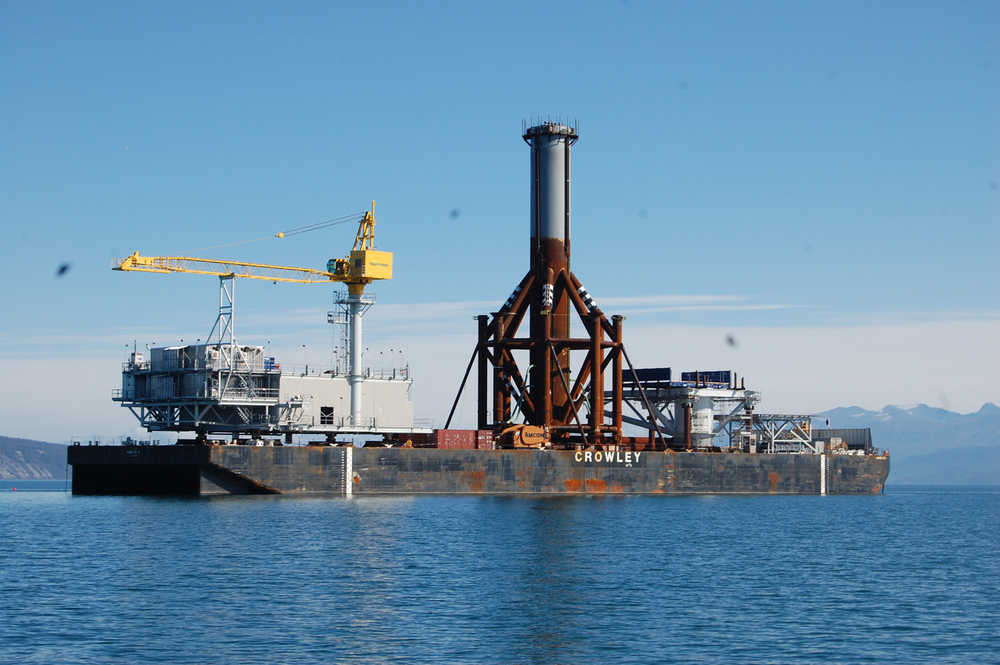State geologists have now increased the amount of natural gas they believe can be economically produced from known fields in Cook Inlet.
The state Division of Oil and Gas concluded, in a recent study, that there may be 440 billion cubic feet more gas in the Inlet’s gas fields than previously estimated.
About 1.1 trillion cubic feet of recoverable gas reserves were estimated in a 2009 resource assessment by the division, and the new figure is about 1.54 trillion cubic feet of gas, according to Paul Decker, acting director of the state Division of Oil and Gas.
Decker presented the estimates in a briefing to an energy task force of Commonwealth North, an Anchorage-based business and public policy group.
The estimates are derived from data available to the public from a handful of the Inlet’s larger producing gas fields and do not include resources that could be added from three recent gas discoveries where the estimated volumes are still confidential, Decker said.
It’s not known, however, whether the new estimates mean there’s enough gas in the Inlet to supply future utility needs, a possible restart of the Agrium fertilizer plant near Kenai and possibly supplying gas to Fairbanks. That will probably take continued exploration and investment in the producing fields, Decker said.
Gas from the North Slope will still be needed someday, he said.
The increase in estimated reserves is good news, though, because just a few years ago the regional utilities were seriously worried about depleted supply from the region’s gas fields. Imports of liquefied natural gas were being studied as a short-term solution.
What turned things around was the entry of Hilcorp Energy into Cook Inlet and that company’s investment and aggressive redevelopment of the Inlet’s older fields, Decker said. The apparent shortage also stimulated state geologists to reassess what they knew about the Inlet.
Both the 2009 resource estimate and a 2013 update of that assessment included estimates from 28 fields that are known in the Inlet, and a more detailed look at three of the larger fields in the 2013 update. In the 2014 update, there was a more detailed look at four additional gas fields, for a total of seven, of the 28 fields surveyed in 2009.
Meanwhile, there is one new producing field added in the Inlet since 2009. It is the small onshore Kenai Loop field that was discovered and developed by Buccaneer Resources. Buccaneer went bankrupt due to unrelated financial issues but Kenai Loop is still producing. The field is now owned by another company, AIX.
If the new discoveries are developed, additional reserves would be added in Cook Inlet.
Decker said the three new discoveries include one by Furie Operating LLC, at its “Kitchen Lights” find in upper Cook Inlet; BlueCrest Energy LLC at the “Cosmopolitan” offshore deposit near Anchor Point, and NordAq Energy LLC’s “Shadura” onshore gas discovery on the Kenai Peninsula.
Resource estimates by Furie are not public but the production facilities planned by the company, to be installed this summer, will have a capacity to produce 80 million cubic feet of gas per day or 30 billion cubic feet per year, Decker said.
Production facilities and wells planned at Cosmopolitan, where installation is hoped to be done in 2016 and 2017, will be capable of handling 22 billion cubic feet of gas per year, he said.
Production potential at the Shadura onshore discovery is confidential, but the deposit is within the Kenai National Wildlife Refuge, which means that permitting for development would be complicated.
The subsurface mineral rights are held by Cook Inlet Region Inc. but surface production facilities must adhere to regulations of the refuge.
“We believe a tremendous amount of new gas can be discovered in the Inlet,” but it will be found in smaller deposits, Decker said.
“Most of the large structures have been drilled,” in the initial exploration of the Inlet, Decker said. These were the large anticline structures easily seen with the type of 1960s-era two-dimensional seismic exploration imaging technology used when the Inlet was first explored.
Modern three-dimensional seismic now in use is capable of spotting smaller structural traps, he said, and more complex stratigraphic reservoirs.
To date about eight trillion cubic feet of gas has been produced from the Inlet, Decker told Commonwealth North.
The Inlet produces about 115 billion cubic feet of gas yearly including some “associated” gas produced with oil, according to Division of Oil and Gas data.
Electric utilities in Southcentral Alaska and Enstar Natural Gas Co., the regional gas utility, consume about 90 billion cubic feet of gas yearly, and the remaining gas is used as fuel on oil and gas production platforms and by Tesoro, which owns a refinery at Nikiski.
“The 90 billion cubic feet a year of demand does not include potential gas demand if the Agrium plant were to restart, or if gas were provided to the Donlin Creek mine,” if that gold project were developed, Decker said.
It also does not include 4 or 5 billion cubic feet of gas that might be shipped to Fairbanks as liquefied natural gas, which is now being discussed. If other potential demand in the Interior were included, the demand for LNG might reach 8 billion cubic feet per year.
Tim Bradner can be reached at tim.bradner@alaskajournal.com.

